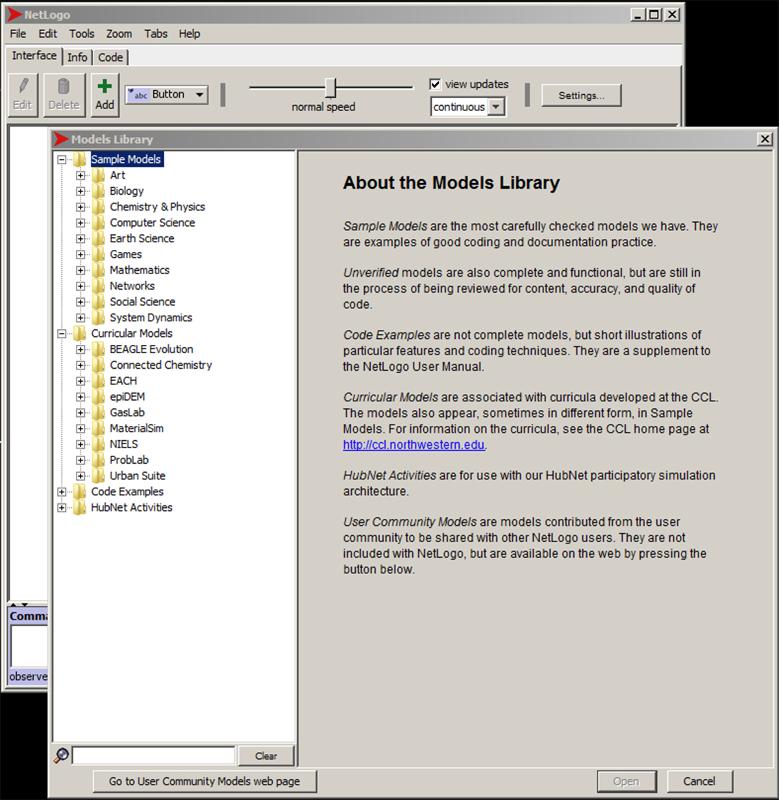(3) Drawing with Rules
Definition: Using simple rules of agent-based behaviors at the micro level to understand how micro actions (at the agent level) affect the macro context to extract a 4D data visualization (with the inclusion of the 4th dimension, sometimes simplified as "time")
Here, real-world data is abstracted into machine rules. In a general sense, "drawing with rules" is also done with other types of computer-based simulations and models.
The basic core of many simulations and predictive programs involves the application of a range of rules (informed by life and statistical analysis) to particular simulated contexts. These may apply to simulation systems like neural networks that play out decision-making scenarios and various outcomes. These apply to other types of predictive modeling as well. (The rules used are a mix of hypothesis and empirical information, which may be used to "train" / inform the evolving simulation.)
NetLogo 5.0.4

Fig. 11: A Screenshot of the NetLogo Models Library
NetLogo is an agent-based modeling language that expresses agent-based actions and decisions at the "turtle" level and their actions on "patches" (set up as a 2D grid or lattice). Some of these models involve parameters which may be adjusted for each run (or "tick" as in tick-tock) for an interactive visualization. Others have defined pre-sets. These are used to understand how simplicity at the agent level may lead to various unpredictable outcomes at the macro level, particularly as something is run over time. These are also used to show changes over time, in the near-term, mid-term, and long-term.
This modeling is based on the concept of "cellular automata," in which similar rules are written for the individual "turtles." The running of sequential iterations or updates sometimes result in surprising patterning, equilibrium states, and complexity.
The models in the NetLogo Models Library are based on findings in the research literature, which are then applied to the coding. These are tightly documented and described, and the code itself is available. It is important to read the notes on the models and actually the original research papers to understand the hidden complexities and assumptions of them model. (In the real world, a model is further nuanced / sensitized or trained with the input of real-world data.)
Note the three tabs: Interface, Info, and Code. These aspects may be understood as the interactive interpreter (Interface), the documentation (Info), and the script (Code) windows. The Interface is where the interactive simulation plays. The Info is editable in the local version. The code here is read-only, but the code may be repurposed in a different model.
NetLogo is an open-source (and free) tool created at Northwestern University by Dr. Uri Wilensky.
Biology / Social Sciences > AIDS
Parameters: initial people, % infected, average coupling tendency, average commitment (serial monogamy), average condom use, average test frequency, and others.
Social Science > Rebellion (based on Joshua Epstein's Model of Civil Violence, 2002)
Parameters: initial cop-density, initial agent-density, vision; government legitimacy; max-jail term; movement?
Social Science > Ethnocentrism (based on Robert Axelrod and Ross A. Hammond's model of ethnocentric agents, 2003)
Parameters: mutation-rate, initial-PTR (potential to reproduce), death rate, cost of giving, immigrants per day, gain of receiving, immigrant-chance-cooperate-with-same, immigrant-chance-cooperate-with-different
(The group will try a few more, but these will have to necessarily rely on intuitions based on the visualization, without prior preparation in terms of reading the notes about the model or looking at the code.)
Sample Models: The NetLogo Models Library contains sample models from a variety of fields: Art, Biology, Chemistry & Physics, Computer Science, Earth Science, Games, Mathematics, Networks, Social Science, System Dynamics, and others.
An online NetLogo dictionary is available.
Dynamical Systems Theory: This dynamics theory examines how the collective actions of many interacting components (or agents) result in complex and changing behavior at the macroscopic level. Complexity may emerge from agents that behave according to a few simple rules
.

Fig. 12: A Quadtych of Four Visualizations from the NetLogo Models Library

